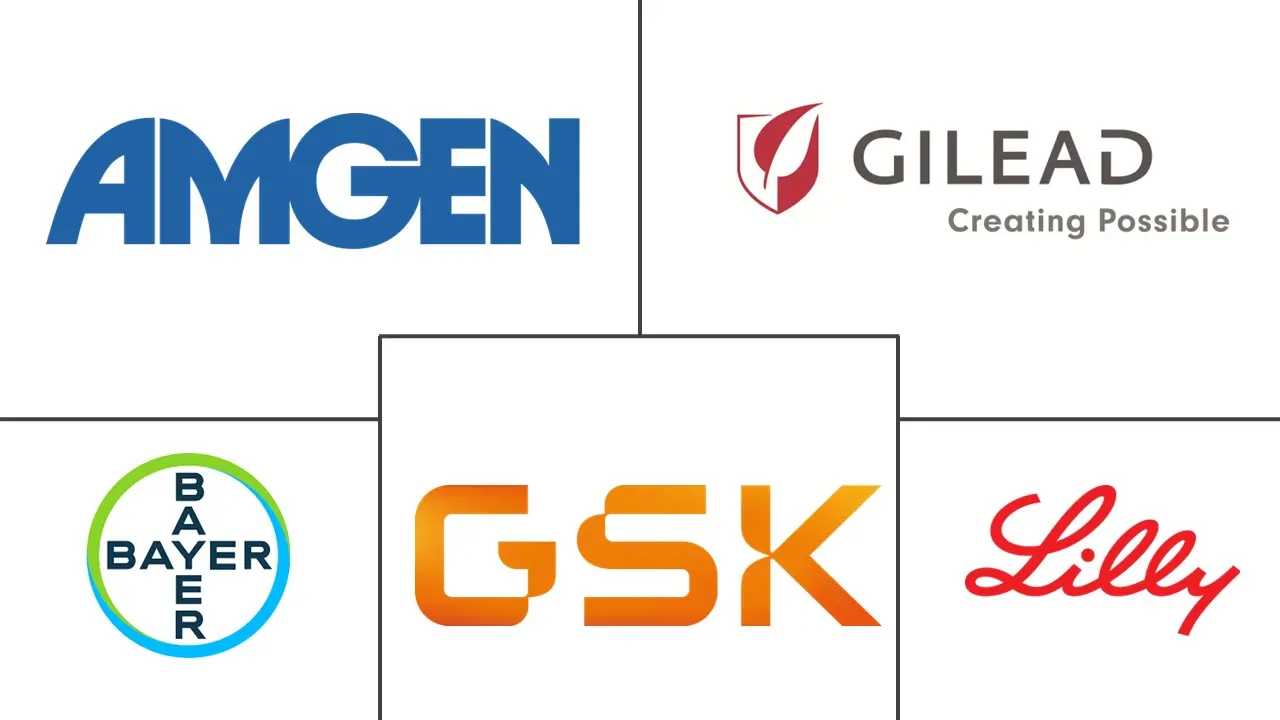Global Angina Pectoris Drugs Market Size and Share
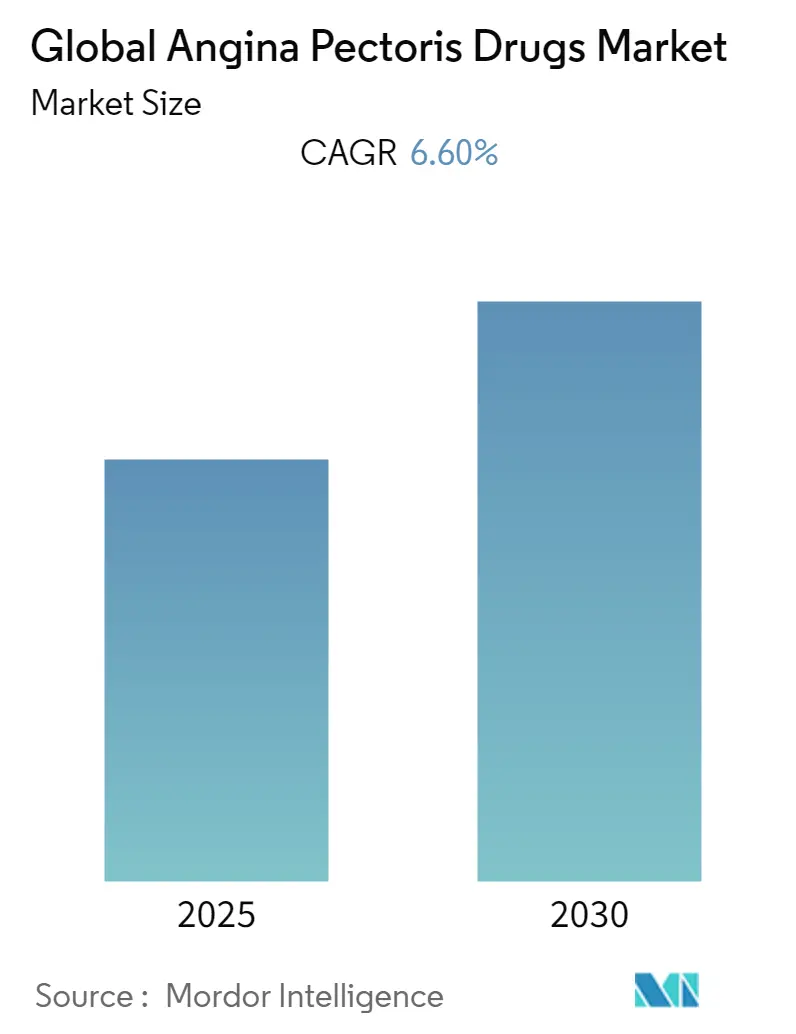
Global Angina Pectoris Drugs Market Analysis by Mordor Intelligence
The Global Angina Pectoris Drugs Market is expected to register a CAGR of 6.6% during the forecast period.
COVID-19 severely impacted the angina pectoris market during the early pandemic due to the lockdown restrictions, a decrease in the number of patient hospital visits, and supply chain disruption. For instance, the article titled "COVID-19 Pandemic and Angina Pectoris: What If the Pain Pathway Is Pharmaceutically Modulated?" published in Pain Medicine, in November 2020, stated that the number of cardiovascular patients attending emergency rooms has decreased in the case of COVID-19. Patients have attributed the contradiction to a COVID-19 phobia, meaning that people with angina pectoris avoid going to emergency rooms since they were afraid of becoming infected with the virus. Such incidents negatively impacted the market's growth in the initial phase of the outbreak. However, the demand for angina pectoris drugs is likely to increase with the growing implications of heart disease among COVID-19 patients. For instance, as per a study titled "Long COVID-19 and microvascular disease-related angina" published in Sociedad Española de Cardiología, in November 2021, after meticulous evaluation and exclusion of other illnesses, the researchers found that 27% of the patients evaluated in a long COVID-19 unit had chest pain, some of which was suggestive of angina. A total of 186 patients were enrolled in the trial, 51 (27%) of whom reported ongoing chest pain after being examined in the long COVID-19 unit. Thus, such studies highlighted the need for drugs to manage angina pectoris in COVID-19 patients, ultimately boosting the demand for drugs. Therefore, the growing number of COVID-19 patients with cardiological complications is likely to boost the market's growth over the forecast period.
Furthermore, factors driving the market growth include the rising burden of lifestyle diseases, especially cardiac disorders; technological advancements towards personalized cardiovascular medicine; and the augmentation of novel drug delivery systems.
One of the major driving factors for the market growth is the surge in the patient population suffering from cardiac disorders such as coronary heart disease. For instance, as per the data published by the World Health Organization, in December 2020, ischemic heart disease was the world's leading cause of death, accounting for 16 percent of all deaths. This disease has shown the highest increase in deaths since 2000, increasing by more than 2 million to 8.9 million deaths in 2019. Stroke and chronic obstructive pulmonary disease (COPD) are the second and third largest causes of death, accounting for around 11% and 6% of all deaths, respectively. In addition, an article titled "Angina: contemporary diagnosis and management" published in PubMed Central, in February 2020, stated that Ischemic heart disease (IHD) continues to be the largest cause of death and lost life years in adults, particularly among women under the age of 55. Angina pectoris is a typical clinical manifestation of IHD and is chest discomfort caused by a heart attack. Thus, the growing number of patients suffering from IHD is likely to impel the market growth for angina pectoris drugs over the analysis period, thereby driving the market growth. However, increasing adoption of minimally invasive surgeries and side effects associated with certain drug classes are some of the factors that may hinder the market's growth in the coming years.
Global Angina Pectoris Drugs Market Trends and Insights
Beta Blockers is Expected to Exhibit a Significant CAGR Over the Forecast Period
Beta-blockers work by blocking the effect of adrenaline on the heart by providing benefits such as slowing the heart rate and reducing the force of heart muscle contraction. In patients with stable angina caused by CAD, beta-blockers are considered first-line therapy. The segment's growth is majorly attributed to an upsurge in the target population and a rising number of strategic developments among the market players for increasing the commercial availability of beta-blocker drugs. For instance, in April 2022, New American Therapeutics granted Melinta Therapeutics the rights to TOPROL-XL (metoprolol succinate) in the United States. TOPROL-XL is a cardio-selective beta-blocker that has been approved by the FDA for the treatment of hypertension, either alone or in combination with other antihypertensives, as well as the long-term treatment of angina pectoris and the treatment of stable, symptomatic heart failure of specific causes. Such developments will bolster the segment's growth in the near future.
Likewise, a research article titled "Pharmacologic Management of Coronary Artery Ectasia" published in Cureus, in September 2021, stated that Coronary artery ectasia (CAE) is a rare type of aneurysmal coronary heart disease that affects only a few individuals. Angina pectoris and acute coronary syndrome are more likely the results of this disorder. The study further stated that patients exhibiting symptoms of angina can be treated with beta-blockers and trimetazidine. Such studies facilitate the use of beta-blockers for treating patients with coronary heart diseases, which, in turn, drives the segment's growth. Hence, the growing number of patients with cardiac disorders, coupled with the increasing commercial availability of beta-blockers and a surge in the use of beta-blocker drugs in treating coronary heart diseases, is likely to boost the segment's growth throughout the forecast period.
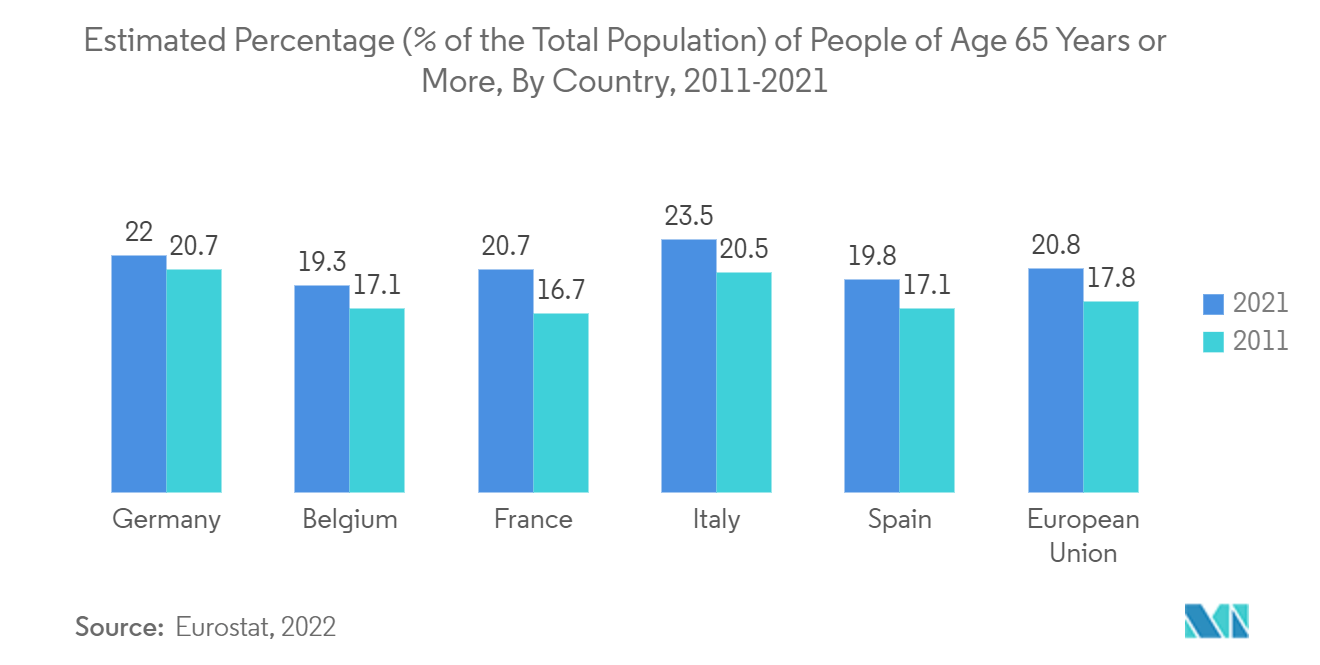
North America Region is Expected to Hold a Largest Market Share of Angina Pectoris Drugs Market
North America dominates the angina pectoris drugs market due to the established healthcare infrastructure, increased adoption of therapeutics, and the presence of key manufacturers in the United States, which is responsible for its large share. Ischemic heart disease is a major cause of death and disability within the North American region, while angina represents its most common symptom. For instance, as per the data published by the National Center for Chronic Disease Prevention and Health Promotion, Division for Heart Disease and Stroke Prevention, in February 2022, the most frequent type of heart disease, ischemic heart disease, claimed 360,900 individual lives in 2019. Coronary artery disease affects approximately 18.2 million persons aged 20 and older. Adults under the age of 65 account for about 2 out of every 10 deaths due to coronary artery disease.
Similarly, an article titled "Ischemic Heart Disease: Noninvasive Imaging Techniques and Findings" published in RSNA (RadioGraphics), in May 2021, stated that in the United States alone, the annual incidence of new coronary events is around 720,000 instances, and the current prevalence of ischemic heart disease is around 18.2 million cases. Thus, such a higher prevalence of heart diseases is likely to increase the incidence of angina pectoris, thereby driving the demand for angina pectoris drugs within the region. Moreover, the surge in the number of clinical trials is also fueling the market's growth. For instance, as of April 2022, there were 23 active and recruiting clinical trials for angina pectoris within the United States. Therefore, these factors together contribute to the growth of the angina pectoris drug market throughout the analysis period.
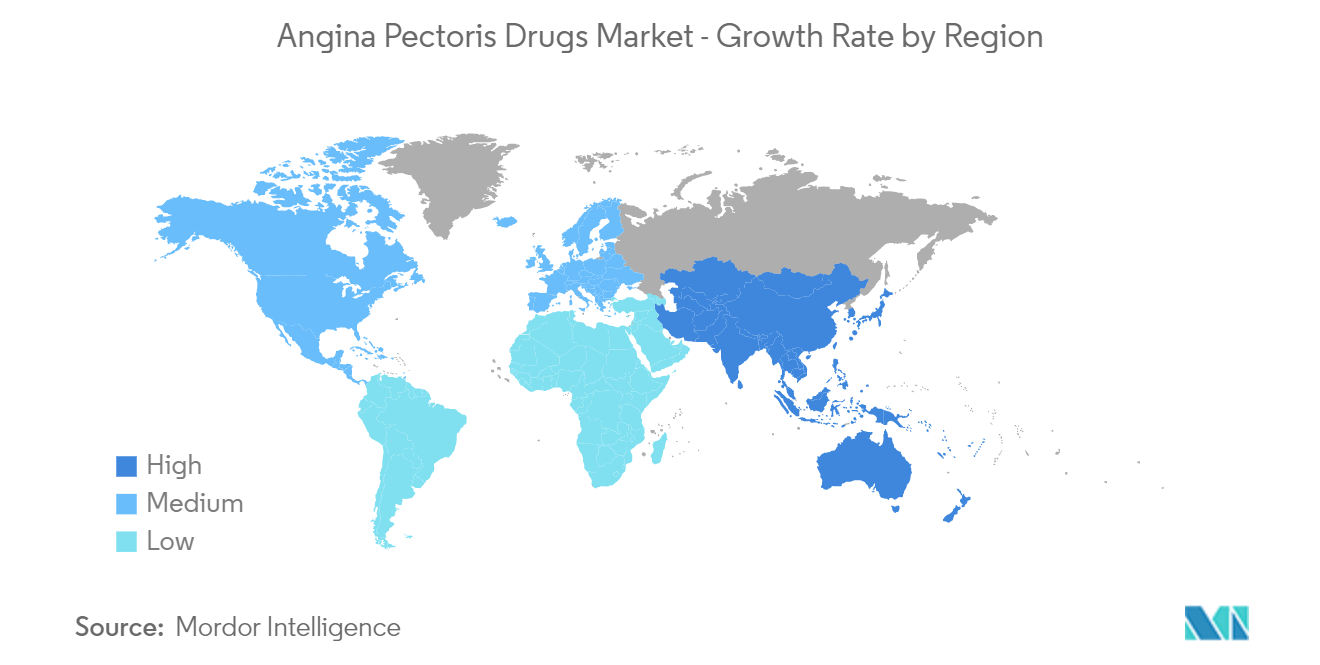
Competitive Landscape
The angina pectoris drugs market is moderately competitive with the presence of many players in the market. Some of the prominent industry players operating in total Angina Pectoris Drugs market include Amgen, Bayer AG, Eli Lilly and Company, Gilead Sciences, GlaxoSmithKline Plc and Merck & Co., Inc. Development of advanced products for better outcomes and rigorous marketing are some of the competitive strategies adopted by market players.
Global Angina Pectoris Drugs Industry Leaders
Amgen
Eli Lilly and Company
Gilead Sciences
GlaxoSmithKline Plc.
Bayer AG
- *Disclaimer: Major Players sorted in no particular order
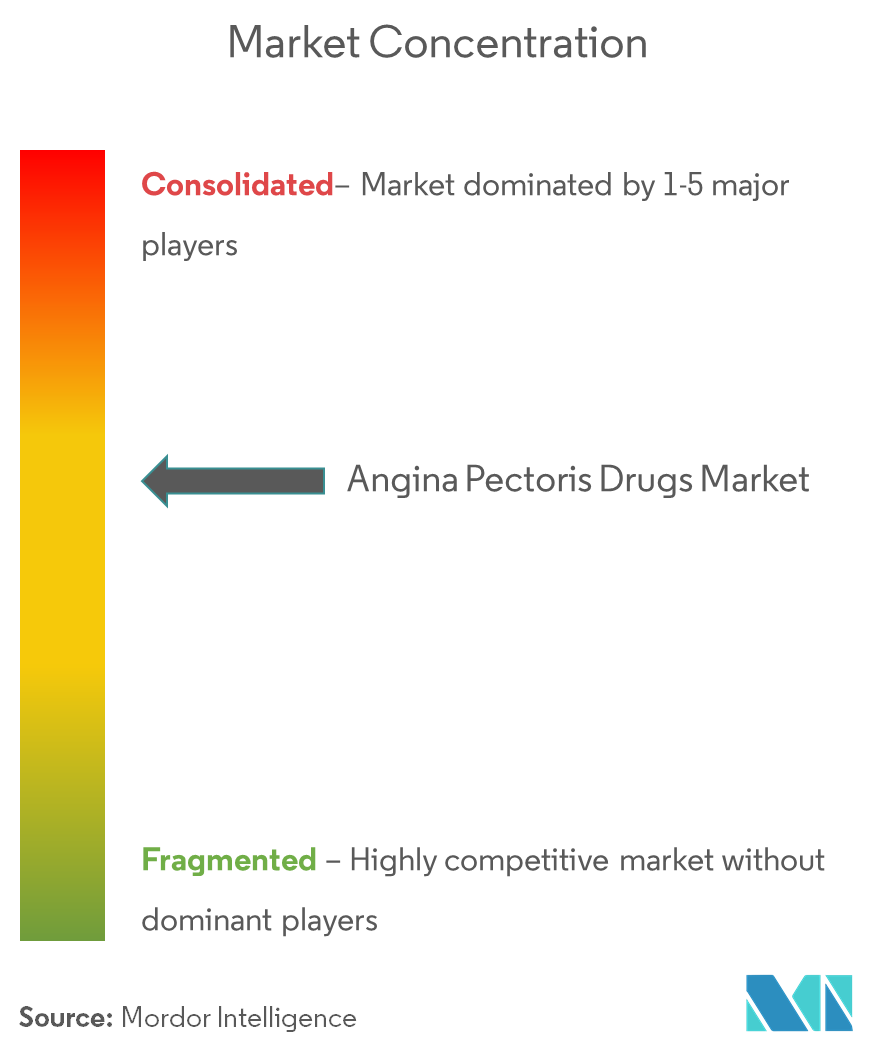
Recent Industry Developments
- In March 2022, Zydus Lifesciences received approval from the United States Food and Drug Administration (FDA) to market its Nitroglycerin Sublingual Tablets in the strengths of 0.3 mg, 0.4mg, and 0.6mg (US RLD: Nitrostat Sublingual Tablets) for angina.
- In October 2021, BioCardia, Inc. announced the treatment of the patient in their CardiAMP Cell Therapy Chronic Myocardial Ischemia Trial for patients with refractory angina.
Global Angina Pectoris Drugs Market Report Scope
As per the scope of the report, Angina pectoris refers to a strangling or pressure-like pain caused by cardiac ischemia. Angina drugs are the initial treatment of angina pectoris. The antianginal drugs recommended for initial treatment are β blockers and calcium channel blockers, which reduce myocardial ischemia by heart rate reduction and vasodilatory mechanisms, respectively. Either or both of these drug classes should be prescribed, together with a short-acting nitrate for prompt alleviation of angina attacks. The Angina Pectoris Drugs Market is segmented by therapeutic class (Beta Blockers, Calcium Channel Blockers, Nitrates, Angiotensin-converting Enzyme Inhibitors, Anti-Platelets, and Others) and geography (North America, Europe, Asia-Pacific, Middle East and Africa, and South America). The market report also covers the estimated market sizes and trends for 17 different countries across major regions, globally. The report offers the value (USD million) for all the above segments.
| Beta Blockers |
| Calcium Channel Blockers |
| Nitrates |
| Angiotensin-converting Enzyme Inhibitors (ACE Inhibitors) |
| Anti-Platelets |
| Others |
| North America | United States |
| Canada | |
| Mexico | |
| Europe | Germany |
| United Kingdom | |
| France | |
| Italy | |
| Spain | |
| Rest of Europe | |
| Asia-Pacific | China |
| Japan | |
| India | |
| Australia | |
| South Korea | |
| Rest of Asia-Pacific | |
| Middle East and Africa | GCC |
| South Africa | |
| Rest of Middle East and Africa | |
| South America | Brazil |
| Argentina | |
| Rest of South America |
| By Therapeutic Class | Beta Blockers | |
| Calcium Channel Blockers | ||
| Nitrates | ||
| Angiotensin-converting Enzyme Inhibitors (ACE Inhibitors) | ||
| Anti-Platelets | ||
| Others | ||
| Geography | North America | United States |
| Canada | ||
| Mexico | ||
| Europe | Germany | |
| United Kingdom | ||
| France | ||
| Italy | ||
| Spain | ||
| Rest of Europe | ||
| Asia-Pacific | China | |
| Japan | ||
| India | ||
| Australia | ||
| South Korea | ||
| Rest of Asia-Pacific | ||
| Middle East and Africa | GCC | |
| South Africa | ||
| Rest of Middle East and Africa | ||
| South America | Brazil | |
| Argentina | ||
| Rest of South America | ||
Key Questions Answered in the Report
What is the current Global Angina Pectoris Drugs Market size?
The Global Angina Pectoris Drugs Market is projected to register a CAGR of 6.6% during the forecast period (2025-2030)
Who are the key players in Global Angina Pectoris Drugs Market?
Amgen, Eli Lilly and Company, Gilead Sciences, GlaxoSmithKline Plc. and Bayer AG are the major companies operating in the Global Angina Pectoris Drugs Market.
Which is the fastest growing region in Global Angina Pectoris Drugs Market?
Asia Pacific is estimated to grow at the highest CAGR over the forecast period (2025-2030).
Which region has the biggest share in Global Angina Pectoris Drugs Market?
In 2025, the North America accounts for the largest market share in Global Angina Pectoris Drugs Market.
What years does this Global Angina Pectoris Drugs Market cover?
The report covers the Global Angina Pectoris Drugs Market historical market size for years: 2019, 2020, 2021, 2022, 2023 and 2024. The report also forecasts the Global Angina Pectoris Drugs Market size for years: 2025, 2026, 2027, 2028, 2029 and 2030.
Page last updated on:
Global Angina Pectoris Drugs Market Report
Statistics for the 2025 Global Angina Pectoris Drugs market share, size and revenue growth rate, created by Mordor Intelligence™ Industry Reports. Global Angina Pectoris Drugs analysis includes a market forecast outlook for 2025 to 2030 and historical overview. Get a sample of this industry analysis as a free report PDF download.
